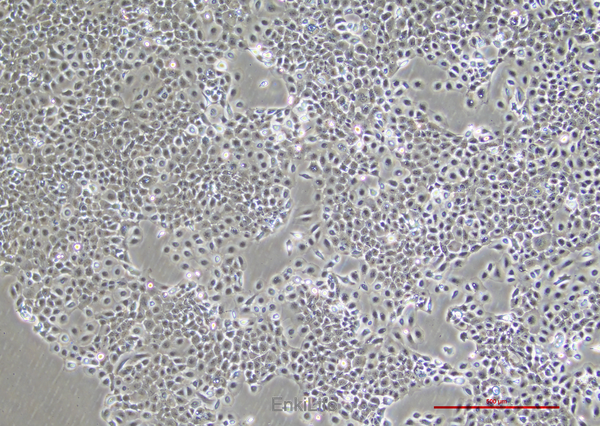宫颈癌肠转移细胞系CaSki
发表时间:2025-07-15人宫颈癌肠转移细胞系CaSki
一. 细胞来源
CaSki细胞系源自人宫颈鳞癌的小肠转移灶,属于HPV16阳性宫颈癌细胞模型。其特点为HPV16基因组高度整合(约400个拷贝),但E2开放阅读框(ORF)保持完整,E2蛋白表达缺失[1]。作为肠转移性宫颈癌的典型代表,该细胞系保留了宫颈癌的分子特征(如HPV16驱动),同时具备转移性癌的侵袭特性[2]。

二. 生物学特性
1.HPV病毒状态
- HPV16基因组高度整合,E6/E7癌基因持续高表达,导致p53和pRb抑癌蛋白失活,促进细胞恶性转化[1][3][4]。
- E2 ORF转录活跃但无蛋白翻译,可能与整合位点表观修饰相关[1]。
2.增殖与凋亡特性
- 高增殖率:HPV16 E7蛋白通过结合pRb释放E2F转录因子,驱动细胞周期进展[4]。
- 凋亡抵抗:E6蛋白降解p53,抑制凋亡通路;靶向E6/E7可恢复p53功能并诱导凋亡[5][6]。
3.转移与侵袭机制
- 上皮-间质转化(EMT):CAIX/PFKFB4轴上调vimentin、下调E-cadherin,促进迁移[7];TGF-β1诱导外泌体miR-663b靶向抑制MGAT3,增强转移能力[8]。
- 信号通路异常:PI3K/Akt通路持续激活,促进Snail介导的EMT[15];Axl受体酪氨酸激酶过表达,由HPV16 E6通过PTEN/AKT调控,驱动侵袭[10]。
4.代谢与微环境
- 糖酵解增强:CAIX(碳酸酐酶IX)高表达与缺氧微环境适应相关[7]。
- 铁死亡敏感:circLMO1可通过miR-4291/ACSL4轴诱导铁死亡,抑制转移[11]。
三. 培养与储存
1.培养基:RPMI-1640 + 10%胎牛血清(FBS),37°C、5% CO?条件下培养[5][12]。
2.冻存方法:含10% DMSO的FBS中液氮储存,避免反复冻融[12]。
四. 研究应用领域
1.药物筛选平台:
- 天然化合物:氧化苦参碱抑制E7表达并诱导凋亡[4];RCE-4(甾体皂苷)激活caspase级联反应[5]。
- 化学药物:二甲双胍通过AMPK/p53轴抑制增殖并诱导凋亡[13]。
2.基因治疗研究:siRNA靶向E6/E7可增敏奥沙利铂化疗,诱导G1期阻滞[6]。
3.免疫治疗模型:抗PD-L1抗体(MPDL3280A)联合DC-CIK细胞疗法显著抑制肿瘤生长[14]。
五. 近五年研究进展(2020–2025)
1.靶向代谢通路:CAIX/PFKFB4轴被确认为转移关键靶点,小分子抑制剂开发中[7]。
2.表观遗传调控:组蛋白去乙酰化酶抑制剂(如VPA)通过Notch通路下调E6,抑制EMT[15]。
3.非编码RNA疗法:抑制miR-21-5p可上调VHL抑癌基因,阻断转移[16];circLMO1过表达触发铁死亡,抑制体内转移[11]。
六. 局限性与克服方法
1.局限性:
- 基因组异质性:HPV16多拷贝整合导致遗传背景复杂[1]。
- 转移模型偏差:肠转移起源可能不适用于原发宫颈癌研究[2]。
2.克服策略:
- 联合多组学分析(单细胞测序)解析异质性[7][11];
- 开发类器官模型模拟原发灶微环境[2]。
七. 总结与展望
CaSki细胞系是研究HPV驱动型宫颈癌转移机制的关键模型。未来方向包括:
1.靶向联合治疗:如Axl抑制剂(BGB324)联用免疫检查点阻断[10][14];
2.代谢干预:靶向CAIX/PFKFB4逆转EMT[7];
3.临床转化:基于circRNA/miRNA的基因疗法进入临床前试验[11][16]。

参考文献
1.Xue Y, et al. Loss of HPV16 E2 Protein Expression Without Disruption of the E2 ORF Correlates with Carcinogenic Progression. PLoS One. 2012;7(12):e52952. PMID: 23285231.
2.Langerholc T, et al. Novel and established intestinal cell line models – An indispensable tool in food science and nutrition. Trends Food Sci Technol. 2011;22:S19-S31.
3.Walboomers JMM, et al. Human papillomavirus is a necessary cause of invasive cervical cancer worldwide. J Pathol. 1999;189(1):12-16. PMID: 10451487.
4.Pei Z, et al. Oxymatrine inhibits the proliferation of CaSki cells via downregulating HPV16E7 expression. Oncol Rep. 2016;36(1):271-274. PMID: 27176755.
5.Wang G, et al. Growth inhibition and apoptosis-inducing effect on human cancer cells by RCE-4, a spirostanol saponin derivative from natural medicines. Int J Mol Sci. 2013;14(10):20251-20269. PMID: 241135810.
6.Aghbash PS, et al. siRNA-E6 sensitizes HPV-16-related cervical cancer through Oxaliplatin: an in vitro study on anti-cancer combination therapy. Med Oncol. 2023;40(3):90. PMID: 36780084.
7.Hsin MC, et al. Carbonic Anhydrase IX Promotes Human Cervical Cancer Cell Motility by Regulating PFKFB4 Expression. Cancers. 2021;13(5):1175. PMID: 33802646.
8.You X, et al. Exosomal miR-663b exposed to TGF-β1 promotes cervical cancer metastasis and epithelial-mesenchymal transition by targeting MGAT3. Cancer Manag Res. 2021;13:1119-1130. PMID: 33574678.
9.Nayim P, et al. CD24 gene inhibition and TIMP-4 gene upregulation by Imperata cylindrica's root extract prevents metastasis of CaSki cells via inhibiting PI3K/Akt/snail signaling pathway and blocking EMT. J Ethnopharmacol. 2021;271:113882. PMID: 33545370.
10.Lee EH, et al. Blockade of Axl signaling ameliorates HPV16E6-mediated tumorigenecity of cervical cancer. Oncotarget. 2017;8(40):68781-68798. PMID: 28978139.
11.Ou R, et al. Circular RNA circLMO1 Suppresses Cervical Cancer Growth and Metastasis by Triggering miR-4291/ACSL4-Mediated Ferroptosis. Mol Ther Nucleic Acids. 2022;27:1165-1173. PMID: 35309564.
12.Liao S, et al. The receptor for activated protein kinase C promotes cell growth, invasion and migration in cervical cancer. Oncol Rep. 2017;38(4):2097-2107. PMID: 28791398.
13.Chen YH, et al. Metformin induces apoptosis and inhibits migration by activating the AMPK/p53 axis and suppressing PI3K/AKT signaling in human cervical cancer cells. Cancers. 2020;12(12):35510. PMID: 332661411.
14.Zheng Y, et al. Combining MPDL3280A with adoptive cell immunotherapy exerts better antitumor effects against cervical cancer. J Immunother Cancer. 2017;5(Suppl 2):P5. PMID: 29034081.
eng S, et al. Valproic acid exhibits different cell growth arrest effect in three HPV-positive/negative cervical cancer cells and possibly via inducing Notch1 cleavage and E6 downregulation. Int J Oncol. 2016;49(2):773-782. PMID: 27278293.
16.Cai L, et al. MicroRNA-21-5p induces the metastatic phenotype of human cervical carcinoma cells in vitro by targeting the von Hippel-Lindau tumor suppressor. Oncol Lett. 2018;15(4):5213-5217. PMID: 29552168.




